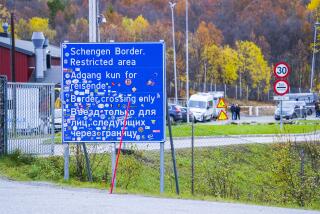Incursions Growing in Potentially Strategic Waters : Soviet Submarines Are a Deep Headache for Norway
BODO, Norway â Suspected incursions by Soviet submarines into Norwayâs deep fiords to test coastal defenses are increasingly worrying military officials in this NATO country.
The Norwegians are convinced that Soviet submarines operating from their base in the Kola peninsula are staging regular forays into their waters, although they have never confirmed spotting one. And even if they trapped one, they admit, they would be powerless to force it to the surface.
âAll the advantages in this hide-and-seek game lie with the sub,â a senior Defense Ministry official said.
So far this year, authorities say they have reacted to 20 submarine alerts from fishermen, coast guards and civilians, nine more than in the whole of last year.
Late last month, spotter planes and surface ships turned out in a typical search of the gray coastal waters after a civilian report of a sighting. It ended 48 hours later with nothing to show.
The waters of the Norwegian fiords, which plummet to a depths of 6,000 feet along the ragged 12,500-mile coastline, are ideal for submarine navigation and unfavorable for sonar detection.
The 1981 grounding of a NATO-termed Whiskey-class Soviet submarine in a highly sensitive military zone in neighboring Sweden raised Norwayâs awareness of its predicament.
Although they instituted new anti-submarine measures last year, including a new network of listening devices at strategic points in the fiords, Norwegian officials make it clear that they still feel very vulnerable.
They are unsure too of Moscowâs exact motives. According to official figures in Oslo, about 60% of the Soviet Unionâs strategic nuclear-armed submarines of the Yankee, Typhoon and Delta classes are based in the Kola.
âWe do not know what their specific aim is,â a senior army officer said in northern Norway recently.
âIt could be to see where our surveillance equipment is placed. They could be checking out navigation conditions. They could be working out the chances of bringing in spetsnaz (sabotage forces) in wartime,â Maj. Gen. Dagfinn Danielsen, Commander Allied Land Forces, North Norway, told a group of journalists.
A senior Defense Ministry official in Oslo said: âIt could be for them to get deep-water fixes to fire missiles with greater accuracy.â
Conventional NATO theory says that in an East-West war, Norwegian waters would take on a strategic importance for the Soviet submarine fleet, which is part of Moscowâs nuclear balance with the United States.
The most common NATO war scenario envisages the Soviet Union rushing modern attack submarines into the area to prevent Allied reinforcements being ferried to northern Norway from the United States and Britain.
The Norwegian waters, with varying conditions of salt content and temperature, pose a special problem for sonar defenses.
Once a submarine commander knows that he has been spotted--often through radio contact with land intelligence at his Kola base--the odds are heavily in his favor.
âA good commander can take his sub in and out of the different water layers and lead us on a wild goose chase,â one officer said. âIf things get tough, he can simply drop to the bottom, turn off his engines, stop all conversation on board and go to sleep for a while. If he wants, he can slip underneath a civilian ship and shadow it and avoid detection that way. He has all of the advantages.â
Finally, when an intruder has been located there is the problem of how to force him up.
âA Soviet commander is under instructions not to reveal himself. Short of surrendering his vessel, that is the worst thing he can do,â a Norwegian officer said.
More to Read
Sign up for Essential California
The most important California stories and recommendations in your inbox every morning.
You may occasionally receive promotional content from the Los Angeles Times.










